

Recycling a guitar
Again and again, when I look through my "leftovers" during my work, I am delighted when a piece of wood that accompanied me for decades finally finds its place. With many originals from the Renaissance and Baroque, you can see that they did the same. For example, the stripes of the neck ornamentation were often not cut from one piece, but were put together from various leftovers.
Today we forget that in those days it was not possible to order everything on the internet. I am sure that in the past there was no waste, but every piece was processed somehow and somewhere. Today, because of scarce ressources, we are no longer in a position to work wastefully. With this background, the work on the instrument, which I describe in the following, has given me particular pleasure.
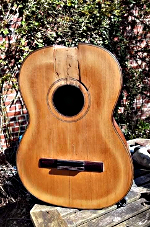 Some time ago I was given a guitar by P.J. Jerusalem, a guitar maker from Aachen, for repair. Unfortunately, the sound of the instrument was not satisfactory and so it has lain around unnoticed for a long time. Now I was commissioned, mainly because of the very beautiful Riopalisander, to turn it into a playable instrument again.
Some time ago I was given a guitar by P.J. Jerusalem, a guitar maker from Aachen, for repair. Unfortunately, the sound of the instrument was not satisfactory and so it has lain around unnoticed for a long time. Now I was commissioned, mainly because of the very beautiful Riopalisander, to turn it into a playable instrument again.
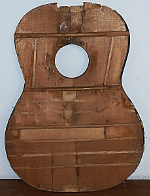 Originally, there was a neck where you could adjust the string action by means of a screw. The soundboard showed some "attempts" to improve the sound. Since it had many cracks and damages I decided to renew the soundboard as well. Therefore, only the sides and back (of the original instrument) remained to be made into a new one. So there was not much left of Jerusalem's guitar.
Originally, there was a neck where you could adjust the string action by means of a screw. The soundboard showed some "attempts" to improve the sound. Since it had many cracks and damages I decided to renew the soundboard as well. Therefore, only the sides and back (of the original instrument) remained to be made into a new one. So there was not much left of Jerusalem's guitar.
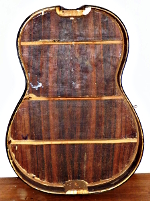 I didn't really like the bars on the back, made of beech. So I replaced them. This gave me the chance to curve the previously straight back. Repairing the existing cracks in the back and gluing a strip to the center joint was, of course, no problem without the top.
I didn't really like the bars on the back, made of beech. So I replaced them. This gave me the chance to curve the previously straight back. Repairing the existing cracks in the back and gluing a strip to the center joint was, of course, no problem without the top.
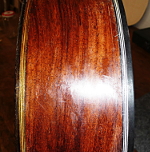 I provided the belly with a contemporary pattern. After gluing it on, it was necessary to make the new edge inlay on the top match the one on the back. The fresh, new look of the inlay was quickly matched to the aged edge inlays on the back with a reach into the bag of tricks.
I provided the belly with a contemporary pattern. After gluing it on, it was necessary to make the new edge inlay on the top match the one on the back. The fresh, new look of the inlay was quickly matched to the aged edge inlays on the back with a reach into the bag of tricks.
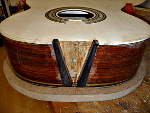 The large cutout for the movable neck would have made a very clumsy foot on the new neck. So I decided to glue in ebony blocks on the right and left. You would be able to see them next to the narrower new neck foot, but I had no better solution. After completion, however, it was hardly noticeable.
The large cutout for the movable neck would have made a very clumsy foot on the new neck. So I decided to glue in ebony blocks on the right and left. You would be able to see them next to the narrower new neck foot, but I had no better solution. After completion, however, it was hardly noticeable.
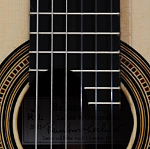 The rest of the work on the neck, head and fingerboard was normal guitar building and needs no further mention. As mechanics there were still a few old Landsdorfer which I have modernized with ball bearings.
The rest of the work on the neck, head and fingerboard was normal guitar building and needs no further mention. As mechanics there were still a few old Landsdorfer which I have modernized with ball bearings.
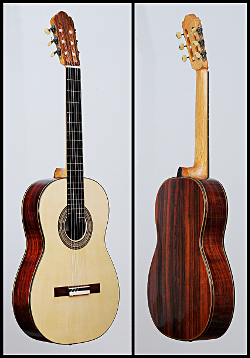 After shellac polishing, the sides and back revealed their full beauty. I left the age-related flaws as they were. The goal was not a new high gloss instrument, but to show that it is an "older" guitar. Visually, the project has resulted in a very beautiful guitar. Whether the rebuild was worthwhile in terms of sound can unfortunately not be documented here.
After shellac polishing, the sides and back revealed their full beauty. I left the age-related flaws as they were. The goal was not a new high gloss instrument, but to show that it is an "older" guitar. Visually, the project has resulted in a very beautiful guitar. Whether the rebuild was worthwhile in terms of sound can unfortunately not be documented here.
If you also own an instrument that needs renovation, please contact me. We can then consider together what is possible and whether it is worthwhile.